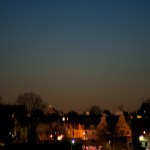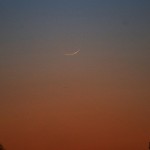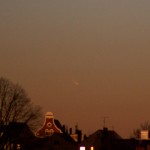 Clear weather has been predicted. And there is a comet in the sky, at magnitude 0.6. Which is pretty bright as such things go. Weeks ago, Olli of the Observatory suggested a certain spot in a small city park opposite the island the historical inner city is built on, on the banks of the Wakenitz, so as to capture the comet against the backdrop of the seven spires of Lübeck. In addition, there is an extremely thin moon sickle, which also makes for a good picture or two.
Clear weather has been predicted. And there is a comet in the sky, at magnitude 0.6. Which is pretty bright as such things go. Weeks ago, Olli of the Observatory suggested a certain spot in a small city park opposite the island the historical inner city is built on, on the banks of the Wakenitz, so as to capture the comet against the backdrop of the seven spires of Lübeck. In addition, there is an extremely thin moon sickle, which also makes for a good picture or two.
So, with a good margin until sundown, I throw my cameras and tripods into the car and drive over there. Not exactly easy, since there have been approx. 2.5 ft of fresh snow over the last two days. I am lucky enough to find a perfect parking spot: right at the corner from which I’d have to continue on foot anyway. A few colleagues from the Observatory are already there and have set up. I get my little folding table and use it to flatten an area of deep snow, compact the area by jumping up and down on it for a bit, and set up my cameras.
 A few passers-by are amazed by the growing forest of cameras and ask whether we are there to shoot the sunset. With combined forces, they are educated about the rare view we are pursuing. The sun finally leaves around ten past six, hiding itself behind the spire of St. Jacob’s. The search for the moon begins, because it is going to be very close to the spot where the comet is expected to make its appearance. Jupiter blinks on, the first stars show up, Olli, for the manyeth time, says “it’s only a matter of minutes now.” After another 60 of those, somebody actually manages to spot the Moon; I have to ask for directions to find it myself, which I finally manage to do through the viewfinder of the camera with the 300 mm lens. Still no trace of the comet, though.
A few passers-by are amazed by the growing forest of cameras and ask whether we are there to shoot the sunset. With combined forces, they are educated about the rare view we are pursuing. The sun finally leaves around ten past six, hiding itself behind the spire of St. Jacob’s. The search for the moon begins, because it is going to be very close to the spot where the comet is expected to make its appearance. Jupiter blinks on, the first stars show up, Olli, for the manyeth time, says “it’s only a matter of minutes now.” After another 60 of those, somebody actually manages to spot the Moon; I have to ask for directions to find it myself, which I finally manage to do through the viewfinder of the camera with the 300 mm lens. Still no trace of the comet, though.
 That remains so for another quarter of an hour, when the first people get a tiny dot of light on the screens of their cameras, against the residual light of sundown. With a little luck, I find a usable angle; through the viewfinder I see absolutely nothing. The “small” camera suffers from its standard lens finally throwing in the towel; may it Rust In Pieces. After that camera’s battery starts to freeze out, I give up on it and unmount it and its tripod. That old thing just is not frostproof. I keep taking exposures of the spot the comet is supposed to be in with varying exposure and iris settings. A look at the screen confirms I have the comet in picture. Across the river, somebody turns on what seems to be an anti-aircraft searchlight that looks like it is pointed straight at us. Wonderful, with the current seeing conditions, that will prove to be really helpful. Not. After about 20 minutes, the thing finally is turned off again, but not without having ruined a large amount of pictures of the comet with light reflections first.
That remains so for another quarter of an hour, when the first people get a tiny dot of light on the screens of their cameras, against the residual light of sundown. With a little luck, I find a usable angle; through the viewfinder I see absolutely nothing. The “small” camera suffers from its standard lens finally throwing in the towel; may it Rust In Pieces. After that camera’s battery starts to freeze out, I give up on it and unmount it and its tripod. That old thing just is not frostproof. I keep taking exposures of the spot the comet is supposed to be in with varying exposure and iris settings. A look at the screen confirms I have the comet in picture. Across the river, somebody turns on what seems to be an anti-aircraft searchlight that looks like it is pointed straight at us. Wonderful, with the current seeing conditions, that will prove to be really helpful. Not. After about 20 minutes, the thing finally is turned off again, but not without having ruined a large amount of pictures of the comet with light reflections first.
When PANSTARRS C/2011 L4 slowly sinks itself behind the buildings of the historic inner city I slowly begin to pack up, make my goodbyes (I was one of the first there, and among the last to leave…) and drive home to check the qualities of the pictures I took. A look at the weather forecast promises good weather for Friday. I hope that that is going to turn true. If so, I am going to use the big rig to get a lot closer to the comet.
